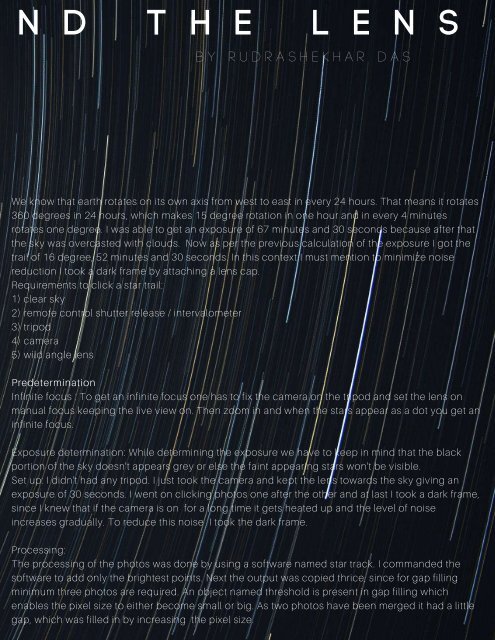INSIDE PHOTOGRAPHY SEPTEMBER,2017
You also want an ePaper? Increase the reach of your titles
YUMPU automatically turns print PDFs into web optimized ePapers that Google loves.
1) clear sky<br />
2) remote control shutter release / intervalometer<br />
3) tripod<br />
4) camera<br />
5) wild angle lens<br />
d T h e L e n s<br />
n<br />
y R u d r a S h e k h a r D a s<br />
B<br />
We know that earth rotates on its own axis from west to east in every 24 hours. That means it rotates<br />
360 degrees in 24 hours, which makes 15 degree rotation in one hour and in every 4 minutes<br />
rotates one degree. I was able to get an exposure of 67 minutes and 30 seconds because after that<br />
the sky was overcasted with clouds.<br />
Now as per the previous calculation of the exposure I got the<br />
trail of 16 degree, 52 minutes and 30 seconds. In this context I must mention to minimize noise<br />
reduction I took a dark frame by attaching a lens cap.<br />
Requirements to click a star trail:<br />
Predetermination<br />
Infinite focus : To get an infinite focus one has to fix the camera on the tripod and set the lens on<br />
manual focus keeping the live view on. Then zoom in and when the stars appear as a dot you get an<br />
infinite focus.<br />
Exposure determination: While determining the exposure we have to keep in mind that the black<br />
portion of the sky doesn't appears grey or else the faint appearing stars won't be visible.<br />
Set up: I didn't had any tripod. I just took the camera and kept the lens towards the sky giving an<br />
exposure of 30 seconds. I went on clicking photos one after the other and at last I took a dark frame,<br />
since I knew that if the camera is on<br />
for a long time it gets heated up and the level of noise<br />
increases gradually. To reduce this noise<br />
I took the dark frame.<br />
Processing:<br />
The processing of the photos was done by using a software named star track. I commanded the<br />
software to add only the brightest points. Next the output was copied thrice, since for gap filling<br />
minimum three photos are required. An object named threshold is present in gap filling which<br />
enables the pixel size to either become small or big. As two photos have been merged it had a little<br />
gap, which was filled in by increasing<br />
the pixel size.


